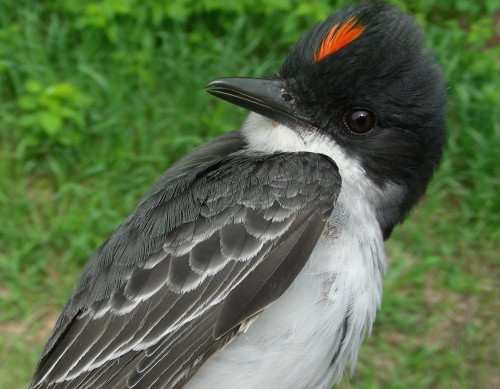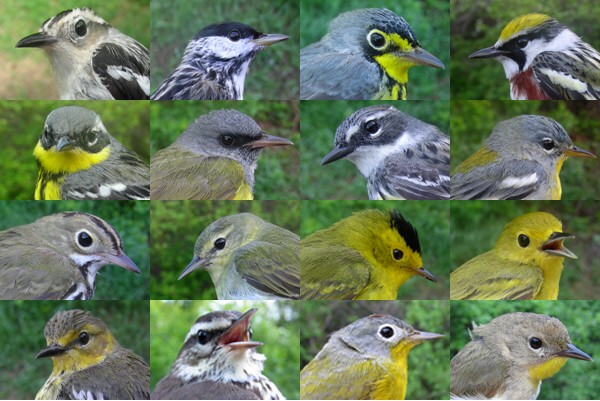|
|
THIS WEEK |
THIS SPRING |
2007 TOTAL |
SITE TOTAL |
|
# birds (and species) banded |
130 (34) |
489 (51) |
530 (56) |
9848 (98) |
|
# birds (and species) repeat |
20
(8) |
64 (13) |
76
(16) |
1625 (52) |
|
# birds (and species) return |
20
(11) |
64 (16) |
68 (18) |
268 (28) |
|
# species observed |
98 |
132 |
132 |
186 |
|
# net hours |
300.5 |
1753.5 |
1790.5 |
15813.3 |
|
# birds banded / 100 net hours |
43.3 |
27.7 |
29.3 |
62.2 |
|
|
Note: table does not include nocturnal banding (owls) |
Banders-in-charge:
Marie-Anne Hudson, Barbara Frei
Assistants: Chris Alsop, Jean Beaudreault,
David Bird,
Jean Demers, Rachel Gosselin, Henderson,
Lance Laviolette, Helen Leroux, Barbara MacDuff,
Chris Murphy, Greg Rand,
Clémence Soulard,
Rodger Titman
|
The annual
MBO Birdathon was held on Saturday, May 19.
Click
here for a full report. |
Notes: The migration floodgates remained stuck in the
open position this week with 14 news species observed and 11 new species
banded. And all this with only 4 days of banding due to bad weather and
our 2007 Baillie Birdathon! The 91 species observed last week has been
eclipsed by this week’s total of 93, but that doesn’t quite echo the
incredible increase seen last year at this time (from 85 spp in week 7
to 104 in week 8). However, the 3 days of extremely chilly weather and
northwest winds this week may explain the lower number of species this
year (though really the weather was far from great at this time last
year too - in fact, we summarized the week as 'dreary', since at least 5
mm of rain fell on 6 of the 7 days in week 8, and daily highs ranged
between 10 and 16 Celsius, better than 2007, but not by much). We
can only imagine what we might see if we ever get a spring with nice
weather during this peak week of migration!
Despite
the bad weather we were able to add the 186th species seen at
MBO: several flocks adding up to about 175 Greater Scaup heading north
over MBO on the morning of the 22nd. We’re slowly making our
way towards 190! Other new species for the year were Black-billed
Cuckoo, a bunch of warbler species, Eastern Wood-Pewee, Wood Thrush (a
rarity at MBO), Veery and Traill’s Flycatcher. Last year at this time,
we were busy setting record after record for the number of species
observed on site. This year things are somewhat quieter, likely due to
the weather – not necessarily the rain, but the persistently cold
northwest winds that dominated the early part of the week. Our peak was
66 species on Friday, with a low of 34 on the very cold and wet
Wednesday. At least in one regard though this week surpassed 2006,
with 16 warbler species banded during the period compared to 10 last
year. In fact, only 15 warbler species were banded during the
entire 2006 spring season, and 14 in 2005, so this week was definitely
exceptional in that regard.
|

This after-hatch year female Eastern Kingbird is only the sixth
ever to be banded at MBO. It just goes to show what thinking
“Hey, wouldn’t it be nice to have a kingbird land in a net?” can
do! (Photo by Marie-Anne Hudson)
|
|
This week's top 10
[last week's rank in brackets
|
#
individuals banded |
mean # individuals observed daily |
|
Red-winged Blackbird (21)
[1] |
Red-winged Blackbird (57)
[1] |
|
Tennessee Warbler (12)
[-]
|
Greater Scaup (25)
[-] |
|
American Goldfinch (11)
[3] |
Tree Swallow
[2]
American Crow
[5]
(22) |
|
Nashville Warbler (8)
[8] |
|
Yellow-rumped Warbler (6)
[2] |
American Goldfinch
[4]
Yellow Warbler
[6]
(16) |
|
Yellow Warbler
[4]
Ruby-crowned
Kinglet [5]
Gray Catbird
[-]
(5) |
Wood Duck (13)
[-] |
|
Ring-billed Gull (11) [3] |
|
Canada Goose
[9]
Black-capped Chickadee
[-]
Song Sparrow
[10]
Common Grackle
[7]
(9) |
|
Warbling Vireo
[-],
Magnolia Warbler
[8]
Common Yellowthroat
[-],
Common Grackle
[-]
(4) |
|
Our top ten species observed is again somewhat
different from last week’s, with a reduction in the number of Red-winged
Blackbirds passing through MBO, though like last year they remain at the
top of both lists. The addition of Greater Scaup is a little
misleading, as they were present for only the briefest moment – their
number simply overwhelmed everything else for the week. The abundance of
Wood Duck, however, is completely accurate. Flocks were 10-15 birds are
seen every day coming and going from the back pond. These flocks
consist of both males and females, so we’re not quite sure what to make
of this. Are these non-breeders, delayed-breeders or even failed
breeders? We’ll be sure to keep our eyes peeled for ducklings in the
near future, as one of our 3 resident pairs of Canada Geese are now
parading around MBO with seven little ones.
Red-winged Blackbirds again dominated the top ten
banded list, but overall the banding numbers were much lower than last
week’s due to the reduction in banding hours. The warblers now occupy 6
of the top ten spots, with Tennessee taking a commanding lead. Their
arrival was quite evident on Sunday morning when the dawn chorus (and
much of the morning for that matter) was absolutely filled with
tikka-tikka-tikka, tsibit-tsibit-tsibit, trrrrrrrrrrrrrrrrriiiiiii!
This Tennessee wave wasn’t seen at all last year, highlighting how
different each season can be, and the importance of continued
monitoring. Though we banded 16 species of warbler, 2 “regulars” evaded
our nets: Black-throated Blue and Black-throated Green Warblers.
However, there’s still one week of banding left, so who knows - though
for some reason both these species are much more common at MBO in fall
(only 1 of 55 Black-throated Blue and 1 of 44 Black-throated Green
Warblers banded at MBO have been caught in spring)!
This
week was rather interesting in terms of returns (greater than three
months between captures) and repeats (less than three months between
captures). When extracting, it seemed as if every third bird was
already banded! Granted it was more like one out of every five, but the
number of returns was quite high, surpassing the number of repeats by a
decent amount. These individuals, most of them banded in 2005, are
likely returning to breed. Since the entire point of banding is to have
as many recaptures as possible, we’re very excited about this flood of
returns, and are eager to see what else is in store for us. Perhaps one
day in the distant future, we’ll have a recovery as important as the one
reported through the latest Bird Studies Canada newsletter: a 33-year
old Northern Harrier was found, more than doubling the previous
longevity record for the species. Though we don't expect passerines to
live anywhere near that long, we’re hoping to accumulate enough
recapture data on our local breeders and winter migrants to establish
some new records of our own!
|

From left to right: FIRST ROW - SY-F
Black-and-white Warbler, ASY-M Blackpoll Warbler, ASY-M Canada
Warbler, SY-M Chestnut-sided Warbler SECOND ROW -
ASY-F Magnolia Warbler, ASY-M Mourning Warbler, ASY-F Myrtle
Warbler, ASY-F Northern Parula THIRD ROW - AHY-U
Ovenbird, SY-M Tennessee Warbler, ASY-M Wilson’s Warbler, ASY-F
Yellow Warbler FOURTH ROW - ASY-F Cape May Warbler,
AHY-U Northern Waterthrush, ASY-M Nashville Warbler, and ASY-F
Common Yellowthroat. (Photos by Marie-Anne Hudson)
|


